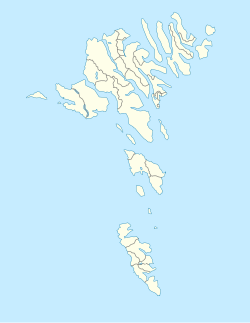Gjógv
| Gjógv | |
|---|---|
| Village | |

Gjógv (2010)
|
|
| Location in the Faroe Islands | |
| Coordinates: 62°19′30″N 6°56′28″W / 62.32500°N 6.94111°WCoordinates: 62°19′30″N 6°56′28″W / 62.32500°N 6.94111°W | |
| State |
|
| Constituent country |
|
| Island | Eysturoy |
| Municipality | Sunda |
| Population (1 January 2006) | |
| • Total | 49 |
| Time zone | GMT |
| • Summer (DST) | EST (UTC+1) |
| Postal code | FO 476 |
| Climate | Cfc |
Gjógv (pronounced [tʃɛkv], literally: gorge, geo, Danish: Gjov) is a village located on the northeast tip of the island of Eysturoy, in the Faroe Islands and 63 km (39 mi) north by road from the capital of Tórshavn.
The village was named after a 200-metre (650 ft) long sea-filled gorge that runs north to the sea from the village.
The village was first mentioned in 1584, but it seems to have existed long before then. It has long subsisted on fishing and selling dried and salted fish (klippfiskur in Faroese). At one time as many as 13 fishing boats sailed from Gjógv. Its population has seen a sharp decline in the past 60 years or so. In 1950 the headcount still stood at 210. A factory producing prefabricated concrete elements was founded in the village in 1982. It employs 6 people and is the only one of its kind in the islands. Other branches of industry are represented by the village's fish farm and guest house / hostel and campsite.
The village church dates from 1929. It was the first one to be consecrated in the village and the first one to feature services in Faroese. Before that, the villagers walked to Funningur for church and burial services. On the opposite side of the road a sculpture stands as a memorial to fishermen lost at sea, bearing the names and ages of men from the late nineteenth to the mid twentieth century. The sculpture of a mother and two children looking out to sea was created by Janus Kamban, (http://www.gjogv.fo/Default.asp?sida=344 says: Fritjof Joensen) who has created a number of Faroese commemorative statues.
The village school building dates back to 1884. It was built from boulders and was once in use by as many as 50 pupils. Now there are only three. The old village dance hall was renovated and extended in 1986 and now houses a community centre. All houses in the village conform to the prevailing colourful style of building in the Faroes, red, white and green being the predominant colours used. There are still about 50 houses left in the village. Due to the great decrease in population, about half of that number stand empty.
...
Wikipedia

